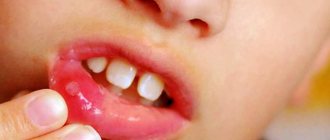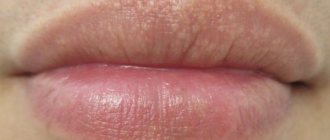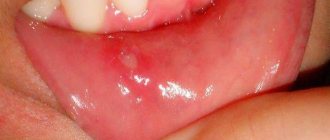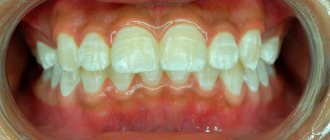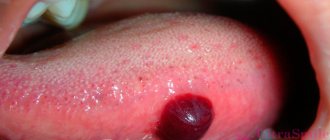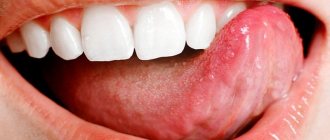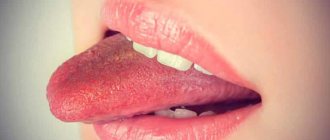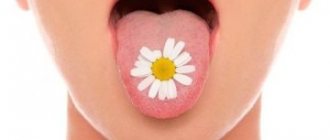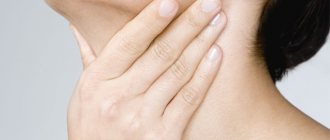Toothache does not always bring us to the dentist. Quite often, problems are caused not by teeth, but by unpleasant sensations in the mouth, red spots on the tongue, and a burning sensation. These signs are characteristic of a variety of diseases, often systemic, but can serve as symptoms of glossitis - inflammation of the tongue.
Features of changing the type of language
The whitish plaque in the form of dots that covers the surface of the tongue is formed due to the fact that the cells of the miniature papillae become rough and keratinized. This phenomenon is caused by:
- the presence of infection inside the body;
- problems with the digestive tract;
- taking pharmaceutical drugs;
- diseases .
How to quickly remove plaque from your tongue
If a person’s health is fine, the tongue has a faint pink tint. A small amount of plaque can be easily cleaned off. The papillae do not thicken. There is no specific smell.
You need to think about the presence of a possible pathology of some organ when a burning sensation or pain occurs, loss of taste, or a feeling of dryness. A sign of a developing health problem can be the fact that the back of the tongue changes color to yellow or gray, and redness appears on the sides. Enlarged papillae become like bright spots.
A plaque is visible on the swollen surface. If you clean it, the dots form again.
Reasons for education
If an adult has spots on the tongue, then a doctor can determine the cause of this phenomenon by analyzing the results of the prescribed examination. Plaque forms not only when inflammation occurs in the internal organs, but also when the disease affects the tongue itself. Such pathologies include glossitis - desquamative, aphthous, ulcerative, mycotic, herpetic.
At the first appearance, red spots appear on the surface, which represent papillae that have changed shape or areas that have lost their epithelium.
With aphthous glossitis, ulcers and a gray coating appear in the upper layer of the tongue, and there is a rotten smell. With pharyngitis or tonsillitis, which is caused by a fungus, mycotic glossitis occurs, which is characterized by whitish dots.
Why does white plaque appear after tooth extraction?
With herpes, blisters form that fill with liquid.
Plaque can also be caused by:
- ignoring hygiene;
- eating food that has a white tint;
- smoking and drinking alcohol;
- thrush;
- candidiasis.
Staining with products such as cottage cheese, sour cream, and sweets disappears quickly, it does not harm health, and the plaque is cleaned off on its own.
Due to improper oral care, food particles remain on the papillae, which provokes the proliferation of microbes and the appearance of a specific odor. You can get rid of such white spots by starting to maintain hygiene.
Which doctor should you contact?
Few people know which specialist to contact if their tongue becomes stained. In fact, a whole group of doctors can help establish the cause of the disease and get rid of it: a dermatovenerologist, an ENT doctor, a surgeon, a dentist, a pulmonologist, a gastroenterologist and others. The first thing the patient should do is visit a therapist or dentist, who, if necessary, will refer him to a more specialized specialist.
Any pathology, be it small red dots or redness of the entire surface of the tongue, requires timely consultation with a competent doctor.
Types of plaque in pathologies of the digestive organs
Acute gastritis is accompanied by nausea and stomach pain. White dots appear on the surface of the tongue. In the chronic form, the plaque takes on a yellowish or gray tint, and the papillae become inflamed. A person suffers from belching and heaviness in the stomach.
The ulcer is characterized by whitish dots that find a place on the root of the tongue. There is an unpleasant burning sensation. With pancreatitis, taste is lost and the mouth feels severely dry. The patient suffers from attacks of severe pain.
With stomach cancer, the entire cavity, and not just the tongue, is covered with a dense coating, from which a rotten smell emanates. It appears due to the release of decay products, the presence of pathological microorganisms, and a large number of leukocytes.
White spots due to fungal and infectious pathologies
A coating on the tongue in the form of white dots is often present at high temperatures, accompanies scarlet fever, and appears during infestation with worms, dysentery, and sore throat. In an AIDS patient, the formation of plaque is facilitated by infections and bacteria, which are sent without obstacles into the body, since the immune system is not able to perform its functions.
With diphtheria, the tongue and oral cavity become covered with white dots. The person cannot swallow. The lymph nodes become swollen and a film forms on the tonsils. Plaque appears during influenza and often indicates the development of vitamin deficiency.
Pimple-like spots are a symptom of stomatitis. With this pathology, many white formations appear, which sometimes merge into a spot. They are observed at the end of the tongue, near the root, and find a place at the base.
5 effective methods for treating plaque on teeth
With candidiasis, plaque resembles cottage cheese and is located throughout the mucous membrane. The rash is accompanied by pain. The disease affects not only infants, it occurs in older children and in people who have low immunity.
White spots against a red frame are observed with aphthous stomatitis, which occurs when viruses enter. With pathology, the temperature rises, sleep is disturbed, and pain makes it difficult to eat. This problem often occurs in children who visit kindergarten, since hands and toys, and with them the infection, find a place in the mouth.
Remove plaque by washing the cavity with antiseptics in the form of Dimexide, potassium permanganate, hydrogen peroxide, Furacillin. Apply Methyluracil ointment. Sprays or aerosols are used to relieve pain.
Teenagers also often develop white spots. They occupy the surface of the tongue and form on the inside of it, in the fold under the lip. Points arise due to:
- frequent colds;
- overwork at school;
- improper diet;
- lack of oral care
White spots in both adults and children sometimes occur due to the presence of the herpes virus. The bubbles that appear burst, and erosion takes the place. It will not be possible to cope with them without the use of Acyclovir.
Oral fibroma
Fibroma is a benign tumor that has the shape of a polyp or dome, that is, it is a formation that resembles a hard, smooth round lump, which with its base or stem is attached to the tissues of the oral cavity. They look like moles and freckles and may have a dark color. Fibroma can occur for various reasons, for example, due to irritation caused by exposure to dental devices, piercings, and teeth.
Therapy for such a tumor can only be surgical; however, surgery does not guarantee that the tumor will not reappear in the same place. Treatment should not be neglected, since fibroids can multiply and grow. In addition, you should avoid damaging the tongue, particularly in the area where the fibroid was previously located. Trauma can trigger its growth again.
Features of plaque in galvanic stomatitis
With galvanic stomatitis, a white coating may appear if there are metal dentures in the mouth that cause irritation. This phenomenon occurs when, when installing them, it was not taken into account that a person has problems with his bite.
Sometimes the tongue is damaged by braces or sharp edges of the tooth. White formations are formed from the remains of the epithelium and pus. They are able to give way to a bleeding ulcer and then a cancerous tumor.
Glossitis, in which the papillae become inflamed, is often preceded by injury to the tongue when biting into hard food. The cavity can be scratched by bone.
9 reasons for the formation of a brown coating on the tongue in adults
Multiple whitish spots can form after taking antibiotics for a long time, since they fight not only bacteria, but also beneficial microflora. There is a plaque in people who have been smoking a lot for a long time. This pathology is called leukoplakia.
The appearance of pimples in the area of the tongue root can be caused by toothpaste containing anise or eucalyptus oil.
Preventive actions
The surest way to avoid such trouble is to follow the following rules:
- proper cleaning of the oral cavity (morning and evening);
- regular visits to the dentist;
- physical activity;
- proper use of medications, especially antibiotics;
- hardening is required;
- healthy eating.
In most cases, staining does not pose a threat to human life. But in order to eliminate the risk of developing severe complications, it is best not to ignore the symptoms that appear, but to seek urgent medical help.
The presence of dots and spots in internal pathologies
Plaque, which is constantly present on the tongue, often serves as a secondary sign of a pathological process that occurs in the body. But a diagnosis is not made based on its presence alone.
White dots cover part of the cavity and tongue of heart patients, people who have problems with the kidneys and lungs. Yellowish or brown plaque accumulates on the surface when the gallbladder is inflamed. The tongue acquires a whitish tint due to anemia, with pathologies that affect the salivary glands.
Dry mouth is characteristic of endocrine disorders. The cavity is completely covered with plaque or individual spots appear. Ulcers and aphthae often form.
Homeopathic remedies for black spots on the tongue
Many doctors, along with traditional remedies for the treatment of tumors on the tongue, also prescribe homeopathic medicines . Below we provide a list of medications that treat black spots by eliminating the main cause of the disease.
| Symptoms | Drugs |
| Fungal plaque, which has various shades from light to black. |
|
| Brown plaque, accompanied by dehydration and stomach diseases. |
|
| Brown plaque, necrosis of the pharynx and palate. |
|
| Brown and black spots in acute respiratory infections with elevated temperature and nasal congestion, the formation of cracks in the corners of the mouth, profuse snot and nasal congestion. |
|
| Brown and black spots, tongue is dry and itchy. |
|
| Dark brown plaque localized in the center of the muscle. |
|
| Black spots. |
|
| Black and black-purple spots on the root of the muscle. |
|
Diagnostic methods
A visit to the doctor cannot be canceled if the white spots on the tongue do not go away. Only after examining the patient will the specialist be able to prescribe the necessary therapy. To find out why the plaque appeared, they take blood for a biochemical analysis, for the presence of sexually transmitted infections, and examine the feces for the presence of worms.
By resorting to fibrogastroduodenoscopy, they check that there are no pathologies of the digestive organs. An abdominal ultrasound procedure is prescribed. Often they turn to an electrocardiogram and resort to gastroscopy.
Allergic manifestations and the result of exposure to certain medications
Certain chemicals, such as bismuth, can cause stains in the mouth. In addition, some medications that are allergens can cause tongue spotting.
To solve this problem, it is important to prevent contact with the allergen, take antihistamines, and continue therapy if the spots do not disappear.
Treatment method
Treatment that will allow you to get rid of white spots on the tongue is prescribed taking into account the identified pathologies. If they are not eliminated, the plaque will form again. Sometimes the problem goes away just by changing your diet and eating habits. Often it is necessary to treat the oral cavity, remove decayed teeth, and remove unsuitable dentures and braces.
When an infection, bacteria or fungi, is detected, a whole range of drugs is prescribed to help cure them. When the body's protective functions are weakened, immunomodulators are used and vitamins are consumed.
If plaque appears due to candidiasis, the mouth should be rinsed well with a soda solution. White dots are cleaned off with sterile cotton wool or a special brush that has a ribbed surface. The tongue and mucous membranes are treated with antiseptics in the form of a solution of Tantum Verde, Rivanol or chlorhexidine.
Let's find out how to remove white plaque on the root of the tongue
Nystatin ointment is applied, which prevents the fungus from spreading. Relieve inflammation with Corsodil. Wounds will heal faster when using aloe liniment, sea buckthorn oil or rosehip oil.
At home, you can get rid of glossitis only at the beginning of its development, if the surface of the tongue is injured by a burn or mechanical force, since self-treatment can lead to a complicated form.
To prevent whiteheads from causing discomfort, you need to prevent their occurrence. Germs will not develop in the oral cavity if you do not forget to brush your teeth. To prevent pathology, products must contain retinol, vitamins B and C. It is worth stopping smoking, abusing alcohol, drinking less coffee and tea, and not indulging in sweets.
Rinsing your mouth with an infusion brewed from chamomile, calamus or calendula helps speed up recovery.
Measures to be taken
Photo 2: If the color of the tumors does not lighten within several days, then it is necessary to urgently visit a doctor to rule out pathologies such as tongue cancer, glossitis and other diseases.
Source: flickr (Olalla Esquimal). To get rid of stains, it is necessary to determine the root cause of their appearance and eliminate it . A number of diseases accompanied by this symptom can be easily cured with the help of medications and vitamin complexes. Along with medications taken orally, treatment of the organ surface . This procedure is carried out using the following means:
- decoctions of sage and chamomile;
- Imudon or Lysobact tablets;
- solutions of miramistin or chlorhexidine;
- treatment in a hospital with liquid nitrogen.
If fungal infection occurs , bifidobacteria and lactobacilli and probiotics are prescribed to normalize the microflora, as well as antifungal drugs such as nystatin, livarol, fluconazole or diflucan.
